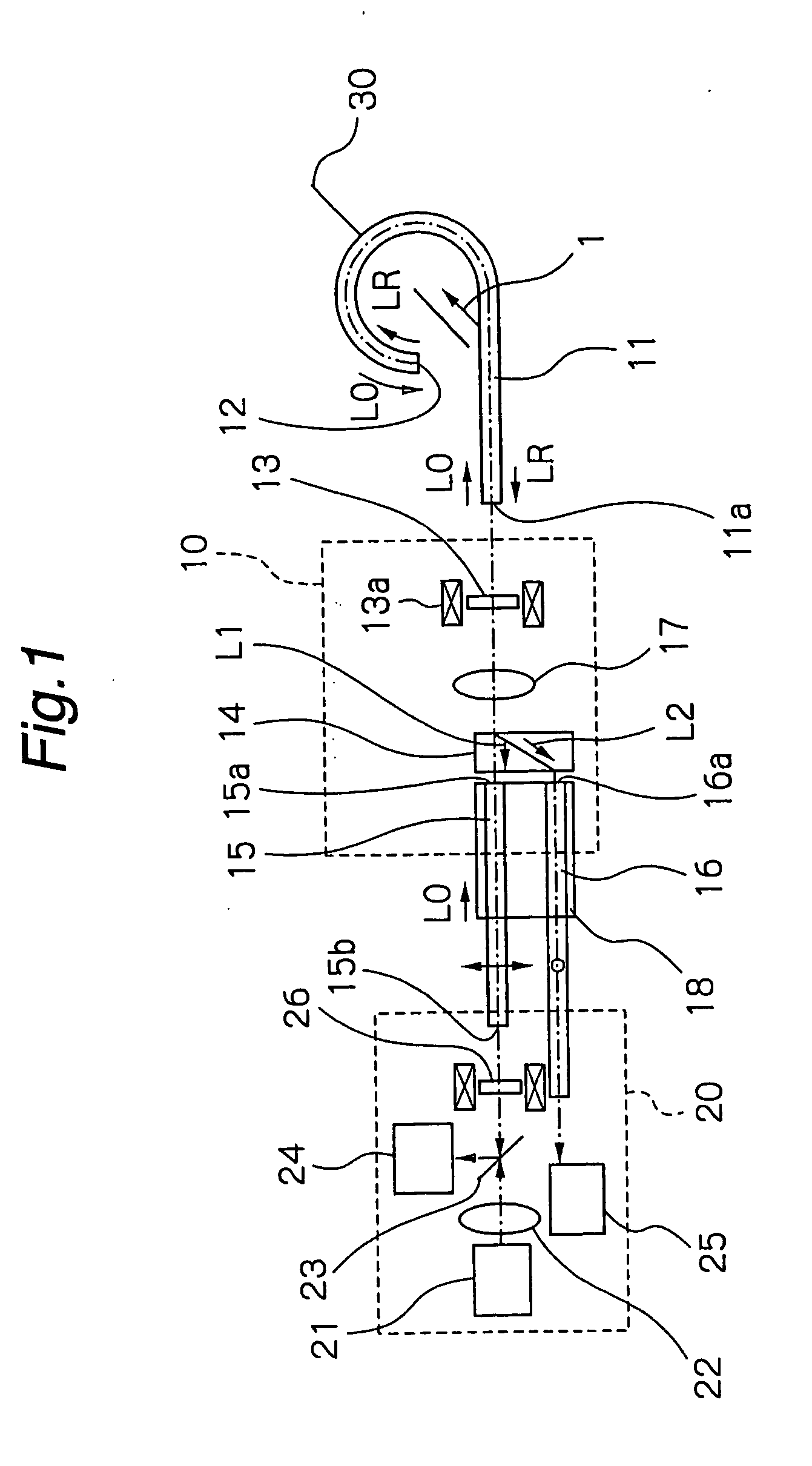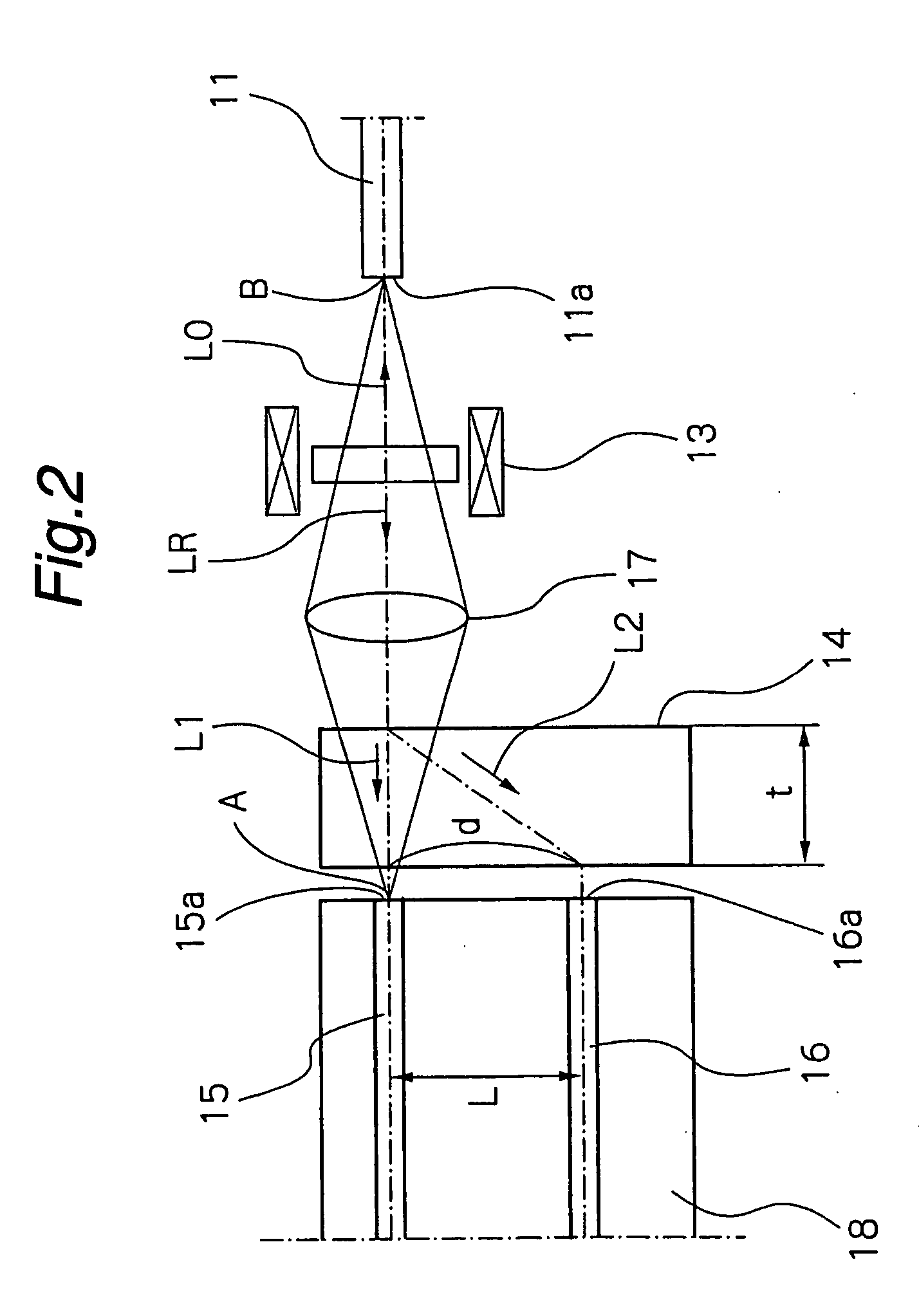Current measuring device
a current measuring device and current measurement technology, applied in the direction of measurement devices, electrical testing, instruments, etc., can solve the problems reducing the number of components and and reducing the size of the photocircuit. , the effect of reducing the size of the photocircui
- Summary
- Abstract
- Description
- Claims
- Application Information
AI Technical Summary
Benefits of technology
Problems solved by technology
Method used
Image
Examples
first embodiment
[0044] Hereinbelow, preferred embodiments of the present invention are described in detail, referring to the accompanying drawings. FIGS. 1 and 2 show a current measuring apparatus according to the present invention. The current measuring apparatus shown in FIGS. 1 and 2 comprises a reflection type optical fiber sensor 11, a photocircuit 10 and a photoelectric converter 20.
[0045] The optical fiber sensor 11 is extended or looped around a conductor 30 through which a current I to be measured flows. The optical fiber sensor 11 comprises a flint glass fiber or a silica glass fiber, through which incident linearly polarized light L0 or reflected linearly polarized light LR is propagated. A reflective film 12 as a reflecting member is provided at one end of the optical fiber sensor 11 so as to reflect the linearly polarized light L0 which has traveled in an optical path encircling the conductor 30. Although the reflective film 12 is provided in this embodiment, this does not limit the pr...
third embodiment
[0096] In the third embodiment arranged as mentioned above, the photocircuit 10 and the photoelectric converter 20a have the advantage of having similar components, which means that the components of the apparatus are less diversified. This provides the added advantage of ease of assembly when forming the components into a unit.
[0097] It should be noted that the angle of Faraday rotation in the first Faraday element 13′ in the photoelectric converter 20a shown in FIG. 4 is 45°, and the angle of Faraday rotation in the first Faraday element 13 of the photocircuit 10 in FIG. 4 is 22.5°.
fourth embodiment
[0098] Next, referring to FIG. 5, a current measuring apparatus is described.
[0099] In the current measuring apparatus in the fourth embodiment, measurement is made with respect to an angle of rotation of linearly polarized light in a current detection optical fiber sensor 102, which is caused by the Faraday effect under a magnetic field produced by a current flowing through a conductor 100. This current measuring apparatus comprises the optical fiber sensor 102 for detecting a current flowing through the conductor 100, a photocircuit 104, a photoelectric converter 106 for converting an optical value from the photocircuit 104 into an electrical value and optical fibers 108, 110 and 112 for connecting the photocircuit 104 and the photoelectric converter 106. The photocircuit 104 is a circuit for inputting, to the optical fiber sensor 11, linearly polarized light obtained from the linearly polarized light or randomly polarized light emitted from a light source 114. It is also adapted...
PUM
 Login to View More
Login to View More Abstract
Description
Claims
Application Information
 Login to View More
Login to View More - R&D
- Intellectual Property
- Life Sciences
- Materials
- Tech Scout
- Unparalleled Data Quality
- Higher Quality Content
- 60% Fewer Hallucinations
Browse by: Latest US Patents, China's latest patents, Technical Efficacy Thesaurus, Application Domain, Technology Topic, Popular Technical Reports.
© 2025 PatSnap. All rights reserved.Legal|Privacy policy|Modern Slavery Act Transparency Statement|Sitemap|About US| Contact US: help@patsnap.com



